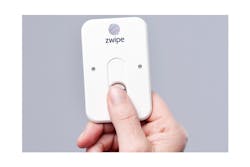While the access control market has been abuzz in recent years over developments in mobile technologies and hosted access platforms, the fact remains that traditional credentials - such as proximity and smart cards – remain the preferred solution for most applications. Now, one company is looking to further improve upon current smart card technology by adding biometrics to the equation.
Based in Oslo, Norway, Zwipe will be introducing its new biometric card, which combines a contactless smart card credential with an on-card fingerprint scanner, in April at ISC West in Las Vegas. According to Zwipe CEO Kim Kristian Humborstad, the company came up with the idea to develop a biometric card after seeing the dearth of contactless credentials available in the market that provided both adequate security as well as convenience.
“You either had to choose between security, which was quite cumbersome, or decide to go with easiness, which was never really secure,” explained Humborstad. “We thought that combining the contactless interface with a fingerprint scanner would be a very simple way to authenticate a user and it will also take care of privacy (concerns) which has grown to be a very important issue nowadays. With the Zwipe concept, you store all of your sensitive data on your own card that you carry with you at all times.”
Compared to other smart cards on the market, Humborstad said the Zwipe biometric card provides organizations with a “very user-friendly” authentication method.
“You move the security aspect from proving that you know something – a code or something like that – to your physical body,” he added. “That is, of course, a much more secure way to authenticate yourself. With the release of the new iPhone, the trend is now going very strong towards biometrics, so we see that a lot of companies who want to be considered high-security moving towards biometrics.”
In addition, Humborstad said organizations that adopt Zwipe cards do not have to replace any of their existing readers and can simply update the card/token that the reader currently uses. “It is a much more cost-efficient approach to security,” he said.
The company will be specifically targeting customers in the government and commercial sectors with its technology initially.
“We have some plans for other markets, but it’s important for us to stay focused on the (government and commercial) markets,” said Humborstad. “We sell to card and reader manufacturers and OEMs and so on.”
Although the Zwipe card costs a little more than a traditional smart card, Humborstad said there is willingness by those who want to pay more for security; however, when compared to other biometric solutions, it is much cheaper. Thus far, he said most of their installations have been within Nordic countries at universities, laboratories, commercial buildings, as well as one government client.
Humborstad said the company has established some relationships with OEM partners and card manufacturers to make a strong push into the U.S. market. In fact, 50 percent of Zwipe’s employees are now in the U.S. and the company opened an office in the Palo Alto, Calif., area late last year.
The company has also attracted talent from some of the access control industry’s biggest players including; Board of Directors Chairman Clas Thelin, former president and CEO Assa Abloy Americas, and Chief Technology Officer Pete Lowe, a former CTO at HID Global. “We think we have quite a strong team for the American launch,” Humborstad said.
Zwipe also raised $3.5 million in funding late last year, which Humborstad said will be used to help grow the company. Humborstad believes that the headlines generated by well-publicized data breaches in recent months bode well for the company as more organizations will undoubtedly be looking to improve their existing security measures.
“When you have all of these cases coming up after (the leaks) from Mr. Snowden… there were really some significant weaknesses exposed in traditional (physical and logical) access systems,” said Humborstad. "Then, with Apple launching the new iPhone last year, we saw that it was very much feasible to make good biometric products and we’ve just seen a huge transformation from people thinking that biometrics are something for just very small niches to being the big thing. I have heard people say, ‘biometrics are the new black, everyone wants it,’ so we feel really pleased to be a part of that megatrend.”






